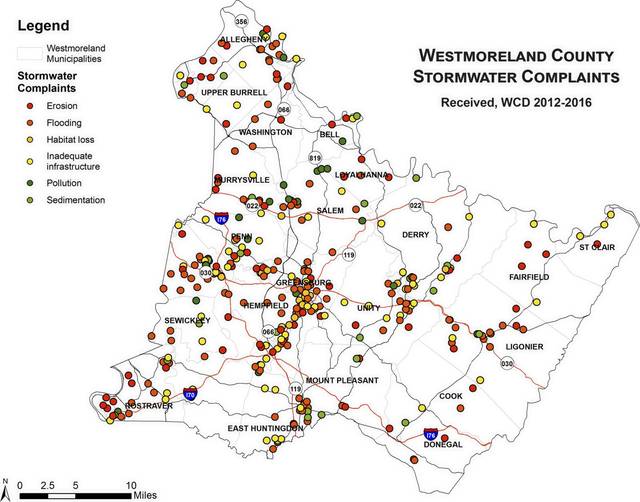https://triblive.com/local/westmoreland/new-flood-plan-close-to-passing-in-westmoreland-county/
New flood plan close to passing in Westmoreland County

Alfred Crimboli of Arona said he knows what caused the flooding that closed at portion of Route 136 several weeks ago.
“Sewickley Creek is plugged up with trees. We get three floods a year there,” Crimboli said Monday during a public hearing for a proposed plan Westmoreland County officials said, once enacted, will help reduce storm water incursions that have caused rivers and streams to overflow their banks, consume roads and filter into homes.
County planners said they have a good idea what is responsible for the flooding near Crimboli’s home and, while cleanup of the clogged waterway is certainly necessary, more proactive measures are needed.
Those measures are outlined in a proposed Integrated Water Resources Plan, a 217-page document county commissioners are expected to approve this week.
The plan calls for a variety of solutions that include the purchase of properties in flood-prone areas, restoration of streams and waterways, installation of mechanisms to collect debris, enhancement of drainage systems and more basic suggestions, such as planting trees.
“Municipalities, watershed groups, homeowners all need to work together. This plan encourages that,” said Jim Pillsbury, an engineer with the Westmoreland County Conservation District, which formulated the proposal to reduce flooding.
Commissioners conducted an initial public hearing in May.
More than 200 flooding incidents have been reported to county public safety officials since 2012, a number that planners insist will keep rising. More than 9,000 county residents live in a flood plain putting their homes at risk, with a majority located in Hempfield, Unity and Ligonier townships and West Newton Borough, according to the plan.
The plan, which took more than two years to complete, identifies areas of flood risk as well as maps out the more than 2,300 square miles of waterways that run through Westmoreland County.
Pillsbury said decades of development have come at the expense of proper management of rain water that in many locations has no place to go. About half of county municipalities have inadequate requirements to address stormwater management, he said.
Once adopted by county commissioners and approved by the state Department of Environmental Protection, the plan will require all 65 municipalities to pass within six months a stormwater management ordinance that will put in place requirements for future development addressing issues related to flooding.
“We’re hoping by this time next year every municipality will have adequate ordinances that protects their neighbors,” said Kathy Hamilton, a landscape architect with the Westmoreland County Conservation District.
Pillsbury said the plan will enable the county, as well as local municipalities, to seek additional state funding to pay for some of the proposed actions identified.
“The solutions to all these problems is money,” he said.
Copyright ©2025— Trib Total Media, LLC (TribLIVE.com)
